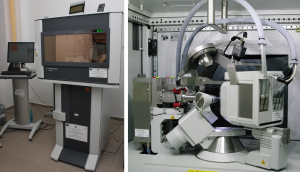 Single-crystal X-ray diffractometer with dual source, SuperNova, Agilent Technologies, UK
Single-crystal X-ray diffractometer with dual source, SuperNova, Agilent Technologies, UK
The single-crystal X-ray diffractometer is equipped with a dual source (Nova™ – Cu and Mova™ – Mo), ideal for analysing crystals containing both low-electron densities and high-electron densities atoms.
The instrument is suitable for collecting data, structure solving and refining of various organic, inorganic, organo-metallic and crystalline macromolecules using direct methods.
Its four-circle goniometer is capable to reproduce and precisely analyse the sample over the angular Phi, Kappa, Omega, Theta, axes and also to monitor and control the distance between the sample and detector.
The CCD – EoS type detector enables to record high resolution data between 0° – 108° (using the Nova™ – Cu micro-focused tube) reaching a value of 0.837 Å as IUCr (International Union of Crystallography) recommends.
 Nuclear magnetic resonance spectrometer (NMR), Ascend 500, Bruker, Germany
Nuclear magnetic resonance spectrometer (NMR), Ascend 500, Bruker, Germany
The Bruker Ascend 500 MHz NMR Spectrometer has been created around an advanced digital concept which is capable of high-speed spectroscopy, flexibility and great accuracy NMR spectra recording. Thereby, the pulse NMR technique and the use of Fourier transform enhances the signal-to-noise ratio and reduces the recording time.
The NMR Spectrometer is fitted with active shielded super-conducting magnet with a magnetic field of 11.7 Tesla and an interior opening of 54 mm. Spectra recording can be performed using several sample introduction systems: 5 mm BBO for the analysis of 1H/13C/15N/19F/31P for the direct analysis and z-axis gradient; 5 mm BBI for 1H, 13C multinuclear inversed detection with increased bandwidth range and z-axis gradient; 1 mm TXI with 1H/13C/15N inversed detection and z gradients. The experiments can be performed at different temperatures, ranging from -150 oC to +150 oC for BBO and BBI and from -50 oC to +80 oC for TXI and limited working range to 0 oC to 80 oC for the shimm system.
The experiments that can be recorded with increased safety for the instrument and with great results for a great range of compounds solubilized in deuterated solvents are 1H-RMN, 13C-RMN, DEPT 135 and bi-dimensional homonuclear and heteronuclear spectra (COSY, HMQC, HMBC), using Bruker TopSpin 3.2 spectra recording and processing software.
The NMR spectrometer is mainly used for structure determination of small organic compounds, macro-molecules, coordinating complexes, isolated natural compound but also for kinetic studies and compositional determination of mixes. The 1 mm TXI is mainly used for samples in µg range, thus being ideal for biological fluids or food products.
 UV-VIS Spectrophotometer, Specord 210 Plus, Analytik Jena, Germany
UV-VIS Spectrophotometer, Specord 210 Plus, Analytik Jena, Germany
The SPECORD 210 Plus Spectrophotometer is intended for spectrophotometric analysis of absorbance, transmittance, reflectance, and energy spectrophotometric analysis for liquid or solid samples, in controlled temperature conditions using a real double-beam, provided with variable spectral resolution system.
The monochromator is diffraction grating type with quartz-covered aspherical optics. The holmium oxide filter and the ultraviolet and visible sources (halogen and deuterium lamps) are fitted to the instrument. The working range of wavelengths is 190 to 1100 nm and the bandwidth is variable (0.5/1/2/4 nm). The wavelength selection accuracy is ± 0,1 nm and the long-term stability of the absorbance measurements, calculated for 1-hour measurement, is ± 0,0005 to the initially read value.
The SPECORD 210 Plus Spectrometer is equipped with the following accessories:
- a solid sample holder for transmittance measurements,
- a device for supporting samples in the form of films or plates,
- an accessory for measuring diffuse transmittance and reflectance, equipped with integrating sphere, able to work in wavelength range of 200-1100 nm, with powders analysis capabilities,
- an automatic suction fluid samples for measurements without changing the sample cuvette, with variable cuvette types (10/20/50 mm),
- Pettier thermostatic device capable of temperature control in the range 10 up to 60 oC,
- a fiber optic probe with adapter for UV probe support able to work in wavelength range of 240 to 1100 nm.
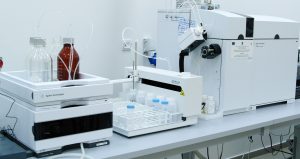 Liquid Chromatography coupled with Inductively Coupled Plasma – Mass Spectrometry, 7700X ICP-MS coupled with Infinity LC 1260 Series, Agilent Technologies, USA
Liquid Chromatography coupled with Inductively Coupled Plasma – Mass Spectrometry, 7700X ICP-MS coupled with Infinity LC 1260 Series, Agilent Technologies, USA
The LC-ICP-MS technique is used for elemental determination from a variety of samples and is one of the most powerful techniques for molecular spectrometry used for unknown substance identification and structural studies in chemistry, medicine, and material science.
The Infinity 1260 LC System enables the use of isocratic or gradient analysis with up to 4 solvents and can be operated with a maximum pressure of 600 bar and a maximum mobile phase flow of 10 mL/min. The autosampler is designed for analysis time reduction, while increasing the sensitivity, resolution, and precision. The temperature-controlled column compartment allows a high level of reproducibility for the retention times.
The 7700x Series ICP-MS is fitted with trace elements analyzer, high-frequency RF generator, matrix introduction system, reaction generation system and a high-frequency hyperbolic quadrupole system.
The mass working range is 2 up to 260 amu with a mass changing rate of 56.6 million amu/s (from Li to U, with data collection for 40 masses). The scanning rate (from Li to U, with data collection for 40 masses) is >3000 amu/sec and the mass resolution is <0.3 amu with abundance sensitivity ranging from 5×10-7 for low masses to 10-7 for high masses. The detection limit for 115In is <0.1 ng/L and for 209Bi is 0.1 ng/L. The precision regarded as the isotopic ratio for 107Ag to 109Ag is better than 0.1.
The high frequency (3 MHz minimum) quadrupole type mass analyzer has a hyperbolic design, ensuring a superior ionic transmission, resolution, and sensitivity with standard settings usage.
The detector is a diode-type electron multiplier that ensures linearity over a great domain of abundances and is capable of two operating modes: pulse, for low concentrations and analog for high concentrations.
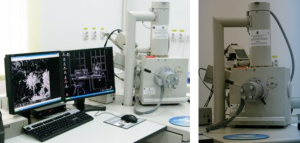 Scanning Electron Microscope, SEM Quanta 250, FEI Company, UK
Scanning Electron Microscope, SEM Quanta 250, FEI Company, UK
SEM Quanta 250 is an instrument with great potential for material science and environmental chemistry studies and can be used for investigating the surface structure and composition of a large variety of materials like aerosols, nanoparticles, pollutants due to the great range of working pressures, from 6×10-4 Pa up to 2600 Pa, supported in the sample chamber.
The instrument provides the optimal solution for image analysis and elemental composition investigation for electrical current conducting and non-conducting samples without any sample preparation in advance and in situ sample modification like hydration and dehydration processes can also be investigated.
The instrument can be coupled with other analytical techniques like X-Ray Spectroscopy, backscattered electrons diffraction and energy dispersive spectrometry. The Quanta 250 SEM main advantages are:
- in-situ dynamic measurements capabilities,
- phase transitions and crystallization observation over the humidity and temperature variation cycles
- particle analysis in suspension and metal corrosion process analysis.
The source fitted to the instrument is made of Wolfram and can generate a high energy electronic beam. Duo to the interaction of the incident electronic beam with the sample, a series of signals are generated be it secondary electrons (SE), backscattered electrons (BSE) or characteristic X-Rays.
There are 3 operating modes available: High Vacuum (HV), the conventional mode for conducting samples (<1.3×10-2 Pa), Low Vacuum (LV), for non-conducting solid samples, powders, or coatings without any prior preparation (~102 Pa), Environmental Scanning Electron Microscopy (ESEM) with software-controlled specimen chamber pressure in the range 10 to 2600 Pa, used for moistened samples or gas-emitting samples (biological samples, nanoparticles-containing emulsions, etc.).
The Quanta 250 SEM is fitted with a EDX Silica Drift Detector (SDD), Apollo X type, that provide a guaranteed resolution of 131 eV or better. The quantification is possible for the elements starting with Beryllium up to Americium.
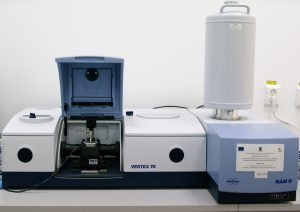 Fourier Transform IR Spectrophotometer, FTIR Vertex-70, Bruker Optik, Germany
Fourier Transform IR Spectrophotometer, FTIR Vertex-70, Bruker Optik, Germany
Vertex-70 FTIR is a spectrophotometer with Fourier transform that allow the investigation of the 8500-350 cm-1 spectral range. The instrument is fitted with a Globar (SiC) source for the Middle IR domain and a Tungsten halogen lamp for Near IR and Visible domains. The DLaTGS detector with KBr window enables the study of the 12000-250 cm-1 spectral range. The ROCKSOLID interferometer, with permanent alignment, is fitted with HeNe, 633 nm, 1mW laser.
The Vertex 70 FTIR is equiped with several accessories like ATR module, and RAMAN II Module. The ATR (Attenuated Total Reflectance) module is fitted with diamond crystal stand that allows the direct investigation of solids, liquids, pastes, gels, and also complex samples. The RAMAN II Module allow the investigation of the following spectral ranges:
- 3500-70 cm-1 for the λ = 1064 nm laser,
- 4500-70 cm-1 for the λ = 976 nm laser,
- 4100-70 cm-1 for the λ = 758 nm laser.
The achieved resolution of the RAMAN Module is better than 0,8 cm-1 and the wavelength selection accuracy is better than 0.01 cm-1.
 Spectrofluorometer, FLS-920s, Edinburgh Instruments, UK
Spectrofluorometer, FLS-920s, Edinburgh Instruments, UK
The FLS-920s Spectrofluorometer is a modular system, capable of spectral scanning, that is intended for steady-state fluorescence measurements, but also for excitation and emission spectra acquisition in the UV-VIS domain.
The instrument is equipped with continuous radiation source, the 450W Xenon lamp (no ozone production). The equipment sensitivity ensures a minimum signal production of 750000 counts/second and a signal-to-noise ratio better than 6000:1 for the RAMAN spectrum of water (recorded at 350 nm excitation and 397 nm emission, with 1 second integration time and 5 nm bandwidth. The continuous Xenon lamp, model Xe900, 450W, can be used for the 230 nm – 1000 nm spectral range).
The excitation TMS300-X monochromator is fitted with a diffraction grating of 1800 lines/mm, optimized at 250 nm, with a resolution of 0.05 nm, wavelength selection accuracy of ± 0.2 nm, a wavelength repeatability of ± 0.1 nm and a shift speed of 200 nm/s.
The emission TMS300-M monochromator, developed according to a Czerny Turner design, ensures a focal distance of 300 mm, entrance slit selection by a diffraction grating with 1800 lines/mm, optimized at 500 nm. The reached resolution is 0.05 nm, the wavelength selection accuracy is ± 0.2 nm, the wavelength repeatability is ±0.1 nm, the shift speed is 200 nm/s and the bandwidth is 0.05 – 18 nm.
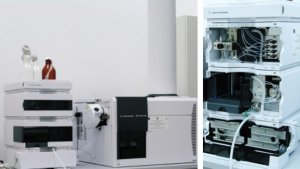 Liquid Chromatograph coupled with Mass Spectrometer, LC-MS-ToF, Agilent Technologies, USA
Liquid Chromatograph coupled with Mass Spectrometer, LC-MS-ToF, Agilent Technologies, USA
The LC-MS-TOF System resulted by coupling Liquid Chromatography (LC) and Time-of-Flight – Mass Spectrometry (MS-TOF). The LC-MS-TOF instrument is developed around a modular concept in which every component has a well-defined role.
The HPLC system’s pump ensures a flow control precision better than 0.07% RSD based on the retention time, a flow accuracy of ± 1% for the flow range of 0.2 up to 10 mL/min. The pump can be suitable operated in the pressure range 0 to 600 bar and the pH 1.0 to 12.5. The column thermostat (model G1316A) allows, for room temperature up to 80 oC range, a temperature stability of ± 0.15 oC.
The manual injector enables the use of volumes up to 500 µL. The automatic injector ensures a precision of 0.25% RSD for a sample viscosity domain of 0.2 – 5 cP. The injected volume can be increased with a 0.1 µL step in the 1 to 100 µL domain.
The Time-of-Flight type mass spectrometer can be used for the m/z domain of 25 to 20000. The ionization source of the detector is electrospray type and ensures a mass accuracy equal or better than 2 ppm. Pesticide database (containing 1500 compounds) and toxic compounds (containing 5000 compounds) enable the investigation of complex systems.
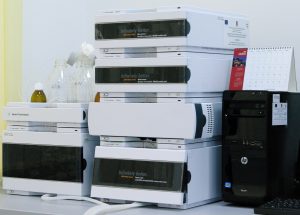 Liquid Chromatograph with Diode Array Detector and Fluorescence Detector, LC-DAD-FL, Agilent Technologies, USA
Liquid Chromatograph with Diode Array Detector and Fluorescence Detector, LC-DAD-FL, Agilent Technologies, USA
The UHPLC 1290 Infinity is a modular system including pumps, autosampler, thermostat, and DAD (Diode Array Detector) and Fluorescence detectors. The G4220 binary pump allows the flow configuration between 0.001 and 5 mL/min with a 0.001 mL/min step and the pressure operating domain is up to 1200 bar. In the thermostated column compartment (model G1316C), with a stability of ± 0.05 oC, up to 3 columns with a length of 30 m can be fitted.
The autosampler is fitted with an injection device capable of covering the 0.1 – 20 µL range, with a precision of <0.25% RSD from 5 to 20 µL and accuracy of ± 1%. The DAD detector (model G4212A) is equipped with a high-resolution 1024 diode network and a long-lifetime Deuterium lamp.
The wavelength selection accuracy is ±1 nm, with autocalibration according to Deuterium lines and embedded Holmium Oxide filter control. The acquisition speed of the spectral data is selectable up to 160 Hz.
The 3D multi-signal fluorescence detector (model G1321A) provides the achievement of a detection limit 10 fg for anthracene. The wavelength repeatability of this detector in ± 0.2 nm, the excitation can be performed an any given wavelength in the 200 – 700 nm range and the emission in the 280 – 900 nm range.
The 1290 Infinity UHPLC system enables the analysis of pharmaceutical products but also for food, life science, environment, forensic etc., samples.
 Organic/ Elemental Carbon Analyzer (OC/EC) SUNSET Laboratory Inc., USA
Organic/ Elemental Carbon Analyzer (OC/EC) SUNSET Laboratory Inc., USA
The SUNSET Laboratory OC/EC instrument enables the analysis and thermo-optical discrimination of organic carbon or optically transparent carbon (OC) from the elemental carbon or optically absorptive carbon (EC) as different particulate matter forms.
The warming of a quartz furnace to 870 ºC, continuously purged with He (providing a non-oxidative environment) allows the thermal desorption of organic compounds and to a lesser extent the pyrolysis products obtained from a MnO2 oxidation furnace that ensure the catalytical conversion of the previously mentioned products to CO2. The catalytical conversion of CO2 to CH4 is enabled using a heated Ni catalyst in a H2 flow and the measurement is performed using a Field Ionization Detector (FID).
The furnace cooling to 600 ºC and the purge of an oxidizing mix (helium/oxygen) facilitates the elemental carbon determination by oxidation from the filter and to the furnace. The pyrolyze process artefacts are corrected using the elemental carbon strong light absorption characteristic. An IR red laser radiation (He-Ne laser) passes thru the sample chamber and the laser transmittance is monitored with completing the heating process. The organic carbon combustion leads to a decrease in the laser transmittance. The elemental carbon contribution can be estimated only by correcting the pyrolysis process.
 High Resolution – Continuous Source – Atomic Absorption Spectrophotometer, HR-CS-AAS, with graphite furnace, hydride generation system and solid samples system, ContrAA 700 Analytik Jena, Germany
High Resolution – Continuous Source – Atomic Absorption Spectrophotometer, HR-CS-AAS, with graphite furnace, hydride generation system and solid samples system, ContrAA 700 Analytik Jena, Germany
The High Resolution – Continuous Source – Atomic Absorption Spectrometer is an important tool for single element or multielement determinations, by using the atomic absorption process, from liquid or solid samples. The ContrAA 700 is a fully automatized compact equipment that is fitted with Acetylene-Air/N2O flame atomization module and graphite furnace module in standard configuration. In addition, a hydride generation system, and a graphite furnace direct solid sample analysis module can replace the standard configuration, depending on the application.
The covered spectral range of the continuous Xe short-arc source is 185 to 900 nm, with lesser than 0.2 nm bandwidth for 200 nm radiation being achievable. The graphite furnace can be hallowed tube or platform type and has a maximum operating temperature of 3000 oC. The sample pipetting and heating through pyrolysis can be observed using the built-in video system.
The spectrometer is equipped with an autosampler capable of automatic dilution if concentrations exceed the calibration curve, automatic calibration standards preparation by proper dilution, automatic standard addition and automatic software-controlled rinsing and washing cycles. The hydride generation can be used in batch or continuous mode, in the latter allowing the determination of Hg, As, Se, Sb, Te, Bi and Sn.
 Multi N/C 3100 Analyzer, Analytic Jena, Germany
Multi N/C 3100 Analyzer, Analytic Jena, Germany
The Multi N/C 3100 Analyzer is an equipment capable of determining the Total Carbon (TC), Total Organic Carbon (TOC), Total Inorganic Carbon (TIC), volatile/non-volatile organic carbon (V/N-TOC) and Total Nitrogen (TN) form liquid or solid samples (e.g. soils). The modular instrument is equipped with two detectors, the non-dispersive IR type for carbon, built of corrosion-resistant material and without moving parts and a chemiluminescence (CLD) type for total nitrogen determination.
The Carbon detector is equipped with a high-power pulsating IR source, with encapsulated optics and high sensitivity microdetector that allows the radiation focalization and precise CO2 detection. The combustion temperature of the liquid samples is 950 oC while 1300 oC is used for solid samples, without the use of any additives. The maximum concentration that can be quantified in liquid samples without any dilution is 30000 mg C/L, while optimal results for the solid samples are obtained below 500 mg C content. The detection limit of the analyzer for liquid samples investigation is 50 µg C/L.
The analyzer is fitted with a flux introduction system for liquid samples, which has automatic wash capabilities in order to prevent cross-contamination. The 60 positions autosampler with xyz controlled movement can be used for mixing, acidification, and individual sample purge.
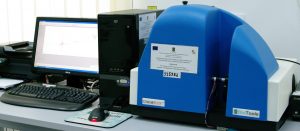 VCD-FTIR Spectrometer, CHIRALIR2XTM, BioTools, UK-USA
VCD-FTIR Spectrometer, CHIRALIR2XTM, BioTools, UK-USA
The CHIRALIR2X instrument is a relatively new concept and is based on Vibrational Circular Dichroism (VCD) Spectroscopy in the Medium and Near IR domains (MIR/NIR). The high-performance MIR FTIR-VCD enables the conformational analysis of chiral, natural (proteins, amino-acids), synthetic (pharmaceutical products), etc., samples.
The system is equipped with SyncRoCell unit – a cuvette rotating platform (dynamic), for arthefact removal that can be used for both FTIR and VCD measurements of solid and liquid samples. The spectral data obtained from the measurements can be compared with the ab initio theoretical results in order to determine the absolute configuration for the newly synthetized molecules. For the molecules with known absolute configuration the enantiomer purity identification in possible.
The liquid cooled MCT detector (Mercury-Cadmium-Tellurium) can achieve resolutions of 4 cm-1 for small molecules and 8 cm-1 for simple proteins. Simultaneous acquisition of IR and VCD interferograms is possible and the signal-to-noise ratio is enhanced by ~3,6 factor relative to any other system by the use of a double source configuration.
The operating spectral range of the instrument is 6500-800 cm-1 without the need of filter changing but the narrow-bandwidth configuration can only be used in the 2000-850 cm-1 spectral range.
The non-polar organic samples are investigated using CCl4 matrix, the polar organic samples using DMSO-d6 and buffer solutions or other suitable solvents are used for biological samples investigation. The IR spectra optimal absorbance recording domain for the analytes is 0.2 up to 0.8 a.u., while more intense signals are recommended for the VCD spectra (in the range of 1 a.u. for every analyte peak) in order to minimize the background noise effect.
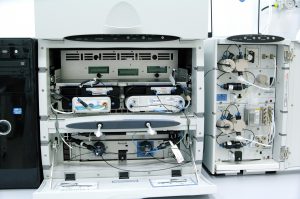 Ion Chromatograph, ICS 5000 Thermo Dionex, USA
Ion Chromatograph, ICS 5000 Thermo Dionex, USA
The ICS 5000 Dionex Ion Chromatograph (IC) is suitable for the analysis of water-soluble ionic species, whether cations (Na+, NH4+, K+, Ca2+, Mg2+) or anions (F–, Cl–, Br–, NO3–, NO2–, SO42-, PO43-). The analytes in IC are ions obtained by the electrolytes dissociation in solution or ions resulted from non-ionic compounds derivatization (organic ligand quantification by complexation) or from weak electrolytes.
The conductivity detector is the modern analytical approach for the experiments that aim at the separation and identification of individual components of the analyte, being characterized by high sensibility, stability, flexibility, accuracy and reproducibility, with a high capacity of providing trustworthy data. For the conductometric detectors, in general, the detector cell is located in a temperature-regulated special enclosure in order to provide isolation from the fluctuating external temperature. A unique head exchanger is used for mobile phase and sample heating before entering the detector cell, providing baseline stability (the temperature-induced current, frequently encountered in other detectors, is eliminated).
The mobile phase may consist of water, strong electrolytes but also organic solvents (polar in water) solutions. The instrument is equipped with electrochemical suppressors (or auto-suppressors) with the purpose of decreasing the conductivity of specific mobile phases and enhancing the conductivity for analytes.
